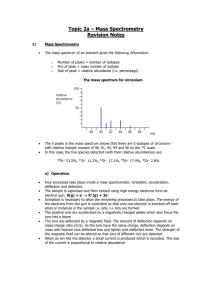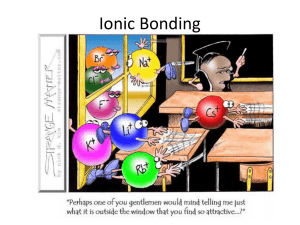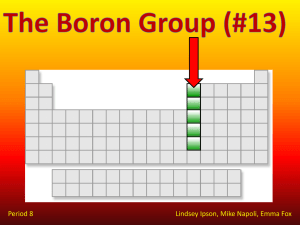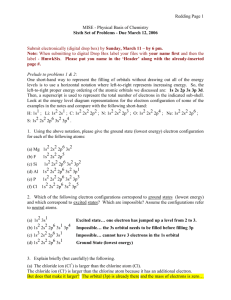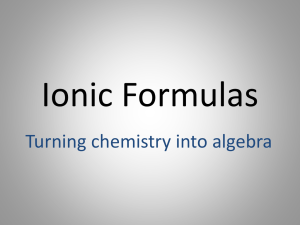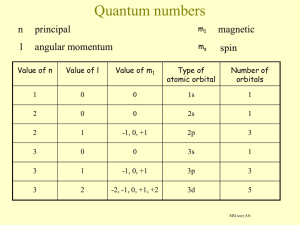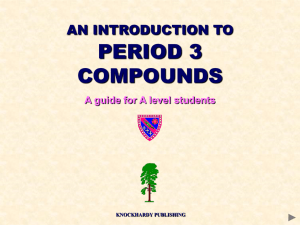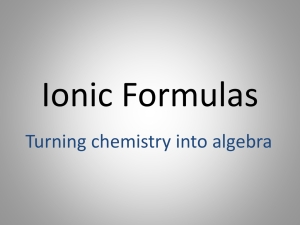ionic bonding - Macmillan Academy
advertisement
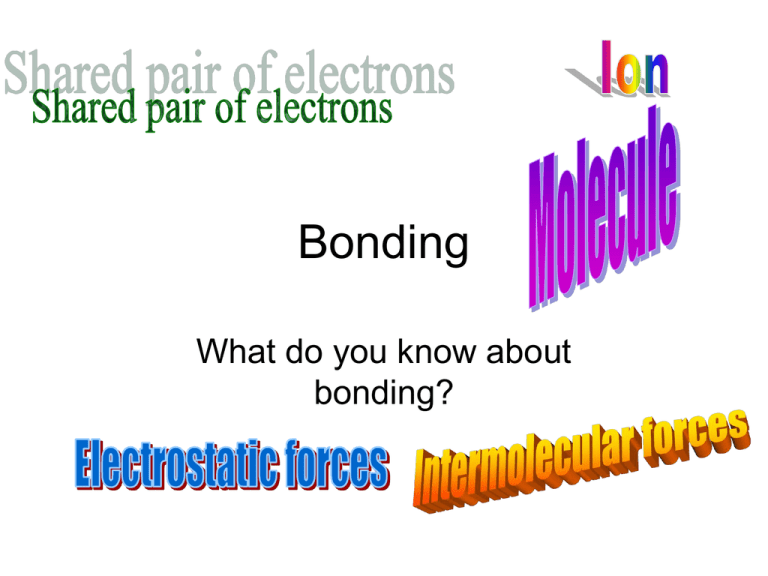
Bonding What do you know about bonding? Learning Objectives • Define Key terms. • Describe Ionic Bonding • Construct Dot/Cross diagrams for ionic compounds. Match up Ionic Bonding Formed when atoms of different elements chemically bond together Covalent Bonding Generally a metal bonded to a non metal. Electrons are transferred, and ions are formed. Metallic bonding. Electrons are shared between all the atoms (delocalised outer electrons) Compound Electrons are shared between 2 non metals Now look in your book for a copy of the ‘definition’ what do you think the key parts are?? Ionic Bonds • Electrons are transferred from the metal atom to the non metal atom. • Oppositely charged ions are formed which are held together by electrostatic attraction. • A giant ionic lattice is formed. THE IONIC BOND Ionic bonds tend to be formed between elements whose atoms need to “lose” electrons to gain the nearest noble gas electronic configuration (n.g.e.c.) and those which need to gain electrons. The electrons are transferred from one atom to the other. _ Sodium Chloride Na 1s2 2s2 2p6 3s1 Cl 1s2 2s2 2p6 3s2 3p5 Na+ 1s2 2s2 2p6 Cl¯1s2 2s2 2p6 3s2 3p6 An electron is transferred from the 3s orbital of sodium to the 3p orbital of chlorine; both species end up with the electronic configuration of the nearest noble gas the resulting ions are held together in a crystal lattice by electrostatic attraction. Half equations and electron configurations Na ——> Na+ + e¯ 1s2 2s2 2p6 3s1 1s2 2s2 2p6 Cl + e¯ ——> Cl¯ 1s2 2s2 2p6 3s2 3p5 1s2 2s2 2p6 3s2 3p6 THE IONIC BOND FORMATION OF MAGNESIUM CHLORIDE e¯ Cl ELECTRON Mg TRANSFER Cl e¯ Mg ——> Mg2+ + 2e¯ and 2Cl + 2e¯ ——> 2 Cl¯ What would the electron configurations be? For all species? (4 of them) Draw your own diagrams with electron configurations and half equations for: Calcium oxide (CaO), Sodium Oxide (Na2O) and Aluminium Fluoride (AlF3) This question is about different models of bonding and molecular shapes. Magnesium sulfide shows ionic bonding. (i) What is meant by the term ionic bonding? ..................................................................... .................................................... ..................................................................... .................................................... [1] (ii) Draw a ‘dot-and-cross’ diagram to show the bonding in magnesium sulfide. Show outer electron shells only. Ionic bonding and the periodic table • 1. Drawn a dot/cross diagram (outer shell) for a) MgO, b) CaBr2, c) Na3P, d) Al2O3 • 2. Write out the electron configuration for K and K+, S and S2- Learning Objectives • State common molecular ions • Be able to predict ionic charge • Apply to exam questions Notes • In general: • Group 1-3 lose elctrons to form the configuartion of PREVIOUS noble gas. • Group 5-7 gain electrons to form the configuration of the NEXT noble gas. • Be, C, B and Si don’t tend to form ions due to too much energy being required to remove electrons. • Transistion Metals: • Iron (II) Fe 2+ • Copper (I) Cu+ Iron (III) Fe 3+ Copper (II) Cu 2+ (Just look at the roman numerals) Ions formed 1 Atom Li 2 3 4 5 6 7 Be B C N O F Mg Al Si P S Cl Ion Atom Na Ion Atom K Ion Ca Br Molecular Ions 1+ 1- 2- 3- Ammonium NH4+ Hydroxide OH- Carbonate CO32- Phosphate PO43- Nitrate NO3- SulphateSO42- Nitrite NO2- Sulphite SO32- Hydrogen Carbonate HCO3- Dichromate Cr2O72- • Some such as NH4+ and OH- can be worked out. • Others such as sulphate, think about what the acid would be. • Working out ionic formulae Calcium Atom Chloride Ion Charge Ratio Ca Ca2+ 2+ 1 Cl Cl- - 2 = CaCl2 Questions Lithium Nitride Calcium Iodide Aluminium Sulphide Magnesium Phosphide Nickel (II) Chloride Copper(I) Oxide Iron (III) Chloride Titanium (IV) Chloride Aluminium Sulpahte Calcium Hydroxide Iron (III) Sulphite Chronium (III) Nitrite Manganese (VI) Oxide Chromium (III) Oxide Ammonium Phosphate Sodium Dichromate Apply to exam question


